Making Your Own Lactose-Free Dairy
The low FODMAP diet is not a diary free diet. It is lower in lactose, however, and this is often a source of great confusion. Lactose and dairy are not the same thing, although they overlap. We highly encourage you to read our article, Lactose, Dairy and The Low FODMAP Diet.
This article here is about how to make your own lactose-free dairy products, such as milk, cream and more. We are taking DIY to a new level with DIY Lactose-Free Dairy!
Let’s Define Lactose-Free
In the FODMAP world, when we say something is lactose-free it can actually mean two things. Something can actually be lactose-free. An apple is lactose free. So are water, steak, rice, lettuce, oranges, chia seeds and many other foods.
They simply do not contain any disaccharides, the “D” in FODMAP, which refers to the two sugars that make up lactose (more on this below).
Then you have foods such as hard cheeses, like Parmesan and cheddar, that are not lactose-free (unless they are alternative versions of their original form), but rather, they are free of enough lactose in the portions recommended to be consumed as to be considered low FODMAP.
This is, in part, how we can eat dairy while on the low FODMAP diet and simultaneously remain low FODMAP.
The main reason these are considered dairy foods is because these products have been made with mammal’s milk (typically cow, sheep or goat).
As an example, Monash tells us that Cheddar cheese has .04g of lactose per 40 g serving. It is not lactose-free, it is just low enough for the low FODMAP diet!
You Can Buy Lactose-Free Milk – for a Price
You can certainly find commercially prepared lactose-free products in your supermarket. Milk, from whole to 2% and skim, is easy to find – but it can be pricey. If you are going to buy lactose-free milk we encourage you to read labels.
Some lactose-free milks have a very simple label, as seen below.
Then, some have more additives than you might have bargained for, as seen below in that image. Note that carrageenan and guar gum are NOT FODMAPs, but if you are trying to avoid them, you might not have thought of looking for them in your milk label.
This label below was found on a lactose-free milk that was also vitamin enriched. I called Hood, the company that makes the LACTAID product shown below, and they told us that the amount of calcium added negatively alters the texture of the milk and that the gums are added as stabilizers.
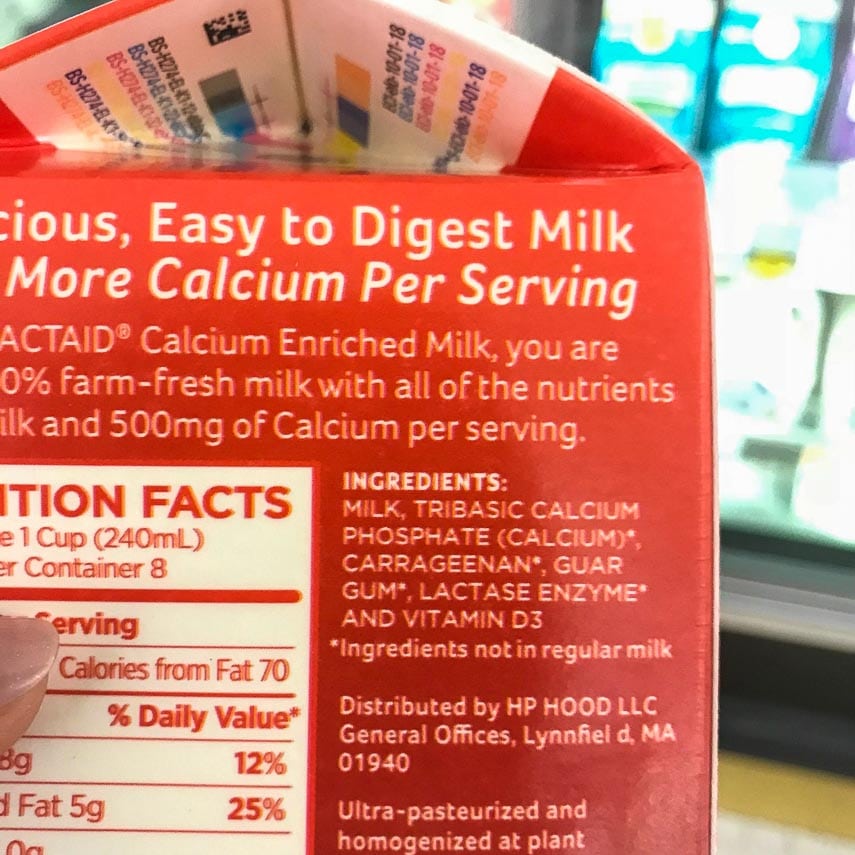
Dairy + Lactase Enzyme = Lactose-Free
As you can see on both labels, the manufacturer has started with pure milk. They have then added an enzyme to render the product lactose-free.
Although all of the labels say, “lactase enzyme”, there are actually several enzymes which could qualify for that term.
Here are some facts:
- We do not know exactly what derivative they have used to produce their enzyme(s)
- We do not know the amount of enzyme(s) used per amount of dairy
- We do not know the amount of time the enzyme(s) have been in contact with the dairy product in order for it to be considered lactose-free
- We also don’t know how they test their products to be able to declare them as “lactose-free”
- And it isn’t clear whether they are totally free of lactose, or free of enough lactose in the serving sizes in order for them to called “lactose-free”
Enzymes
We have a fantastic article on enzymes and their use in aiding digestion and it is a great read.
As for the origin of lactase enzyme in various products, manufacturers do not always readily give us that information.
Lacteeze brand uses a form of tilactase, which is derived from yeast. Many commercial products will source their enzyme from bacteria, yeasts and molds such as aspergillus oryzae and aspergillus niger.
How to Make Your Own Lactose-Free Dairy
Here in the U.S. we have access to lactose-free milk fairly easily. Many well-stocked supermarkets have lactose-free cottage cheese, half-and-half and sour cream. Some specialty stores have lactose-free cream cheese, such as the Green Valley Creamery brand.
In the northeast where we are located, we do not have access to lactose-free heavy cream. Now, Monash University has lab tested heavy cream and it is allowed in 1/2-cup (60 g) portions when whipped and they say 2 Australian tablespoons (40 g) as a liquid, but heavy cream is such a common ingredient in baking and cooking that I wanted to learn how to make my own lactose-free heavy cream, knowing that I could then extend the technique to milk, half-and-half, light(er) creams etc.
Glucose Testing Strips
Lactose is made up of two-molecules – glucose and galactose. They are a class of sugar whose molecules contain two monosaccharides, and as such, these two sugars are the “D” or disaccharide in FODMAP (meaning two sugars).
When lactose is broken down enzymatically it splits into two more readily digestible sugars – glucose and galactose.
It occurred to me that perhaps I could find some glucose testing strips, buy some lactase enzyme and play mad scientist in the Test Kitchen.
Milk contains lactose. If glucose-testing strips were dipped in the milk before adding the enzyme presumably no glucose would be detected, as the molecules would not have been broken down yet. After adding the enzyme they would be.
At least, that was my theory. After a lactase enzyme is added, the sugars are broken down into glucose and galactose. The glucose testing strips would be able to detect the glucose.
Gather Your Tools
I ordered the Lacteeze lactase enzyme drops online.The ingredients are lactase enzyme and glycerol. (The glycerol, by the way, is considered low FODMAP by Monash).
The instructions direct the user to add 4 drops of enzyme to 1 litre (4 ½ cups) of milk and refrigerate for 24 hours. The company says that 70% to 80% of the lactose will be converted. They also suggest that to convert more lactose to add 8 to 10 drops and refrigerate for longer.
Within the Monash University Low FODMAP Training, they state, “add 1 drop of lactase enzyme preparation to 200 ml (⅞ cup) of milk, then refrigerate for 24 hours. Refrigerating for longer will breakdown more of the lactose into individual sugar units (glucose and galactose)”.
I ordered the glucose testing strips from Precision Laboratories. There are other brands, too.
Between the product manufacturer and the directives from Monash I decide to add the equivalent of 10 drops to 1 litre of cream and to refrigerate for 36 hours. At that point I tested the milk with the glucose test strips.
Note that you can do this with other liquid dairy as well, such as milk or half-and-half.
Additional Dairy Products
I have experimented with sweetened condensed milk, as I wanted to be able to make classic desserts like Key Lime Pie and easy fudge. It has been successful, but as sweetened condensed milk is so thick it is important to use the larger amount of the drops and then take care to very throughly incorporate them into the dairy product. I also refrigerate the product for an extended time as well.
Simply test with your glucose strips and if you are not seeing the results you need, add more drops, wait longer, then test again.
Testing, Testing 1-2-3
Before adding the enzyme to the cream, I dipped a glucose strip into some cream, and you can see below that the strip does not change color. This is because the lactose is still present and has not split into glucose and galactose molecules. The strips are testing for the presence of glucose and they cannot register any at this time.
Once the lactase enzyme has done its job splitting the molecules, and therefore making the dairy more digestible for those who have difficulty digesting lactose, the glucose-testing strip does indeed register positive for glucose, as you can see below with the strip turning a dark green color.
How Much Lactose is Converted?
I do not know. I discussed my testing approach with the makers of the strips at Precision Laboratories. They agreed that as the strips turned dark green that we do know that lactose has been converted. We do not know how much.
Our suggestion is to get some Lacteeze drops, add the larger amount suggested to your chosen liquid dairy, such as milk, heavy cream or half-and-half, wait the longer time suggested and then try the dairy and see how your digestive system reacts.
THAT is what is most important, in the end. How do you feel? If you know what your symptoms are when you ingest dairy and you have lesser or no symptoms when ingesting our DIY lactose-free dairy, then this might be a great adjunct for you on the diet.
Here are some dairy-rich recipes for you to try! AFTER you have made your own lactose-free cream!
Low FODMAP Chocolate Crème Brûlée
Low FODMAP Cinnamon Pecan Truffle Ganache Tart
Low FODMAP Chocolate Pudding Pie
Butterscotch Pudding…and MANY more! Just check off “Cheese & Dairy” in our Recipe Filter.
We even have recipes using DIY Lactose-Free Sweetened Condensed Milk, like our Rocky Road Fudge.
And we know you all love our article on Making Your Own Lactose-Free Yogurt, so now you can start with your “own” DIY milk!
And Ice Cream Info!
We have a general article for you – All About Low FODMAP Ice Cream & Frozen Desserts that we think you will love. Get links to recipes and also to dozens of low FODMAP prepared products, both dairy based and dairy-free.
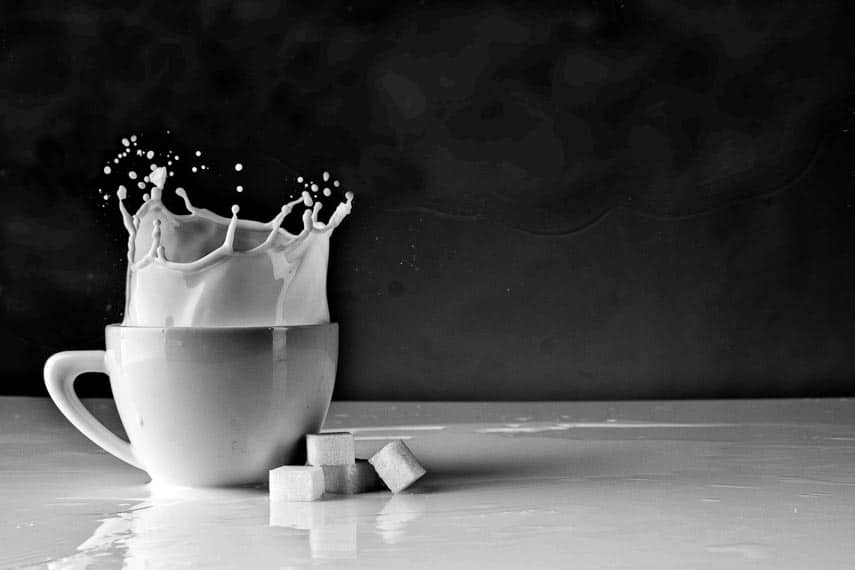
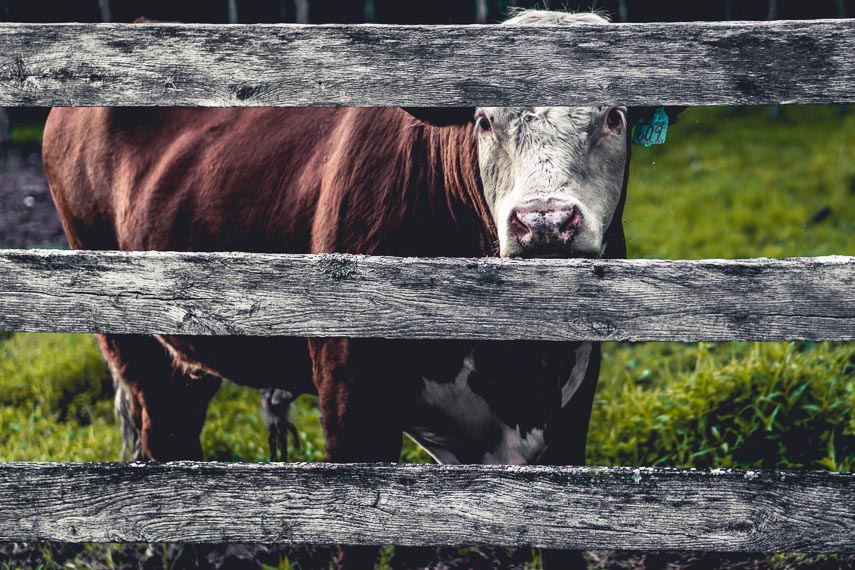
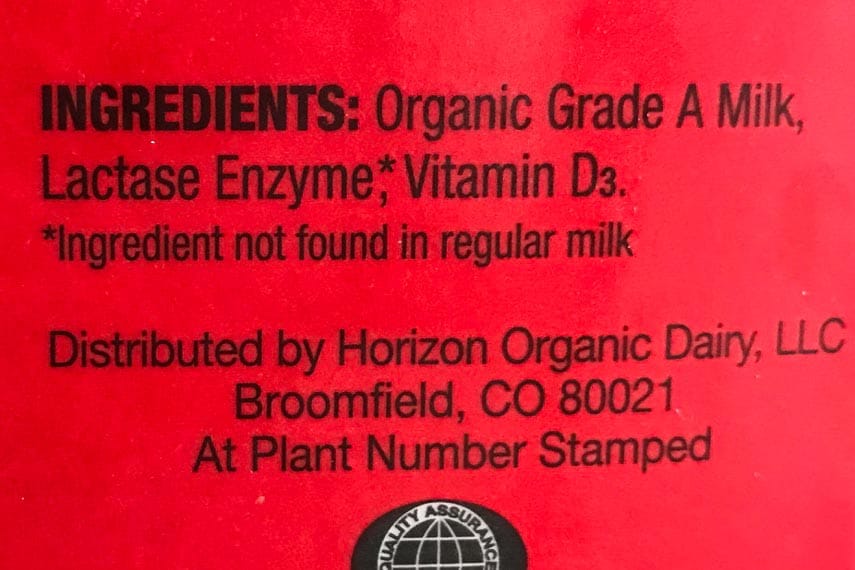
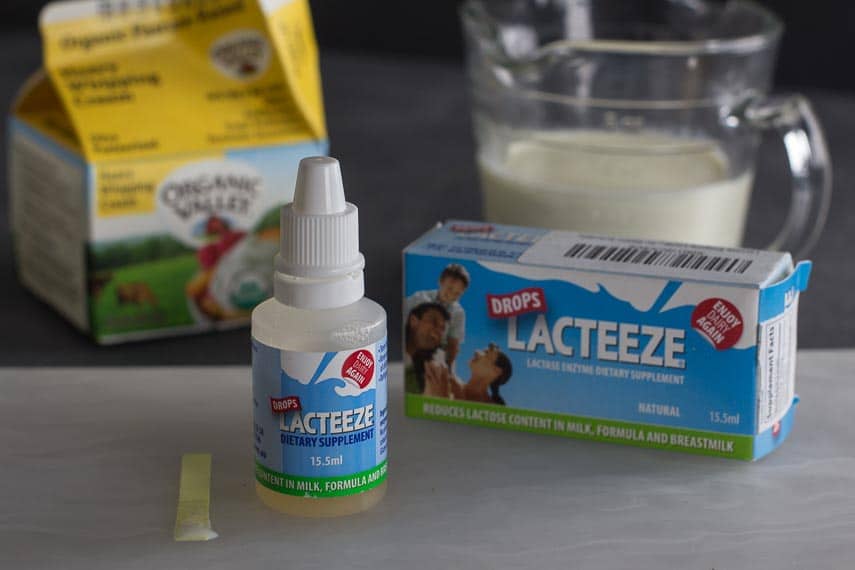
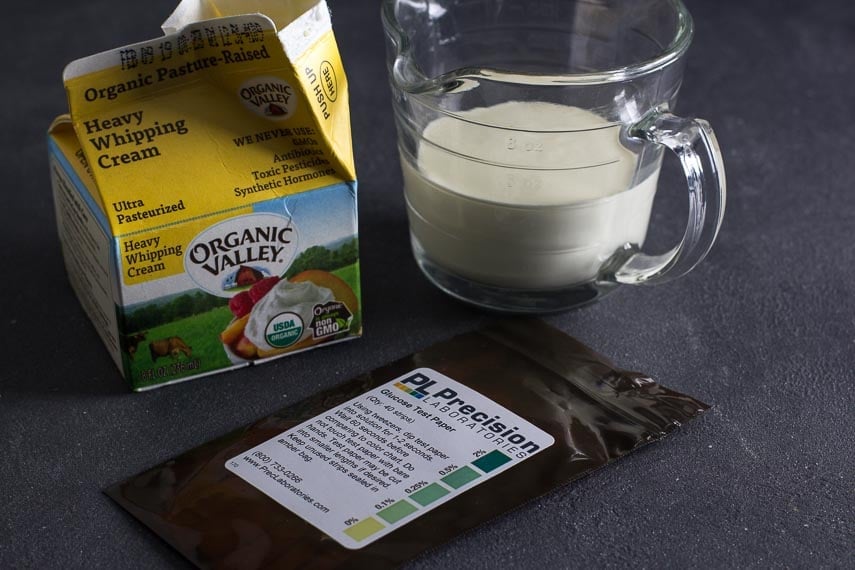
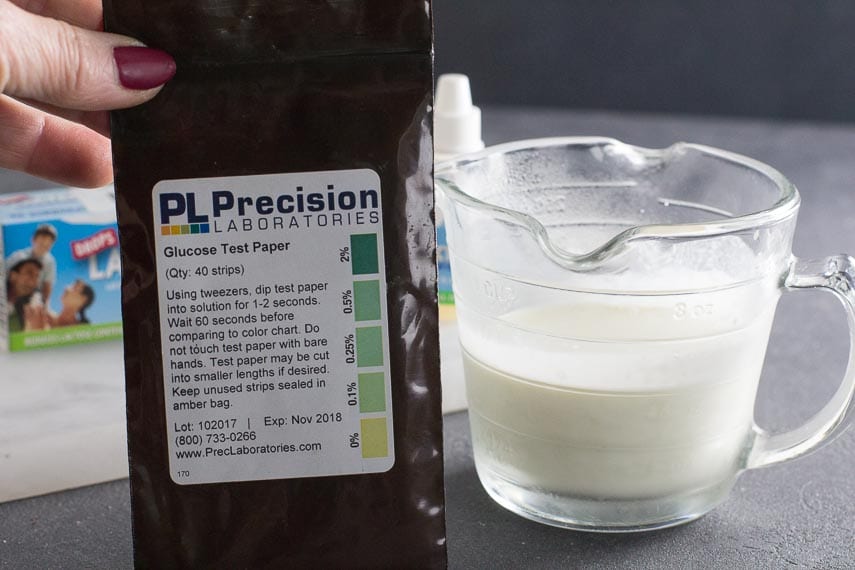

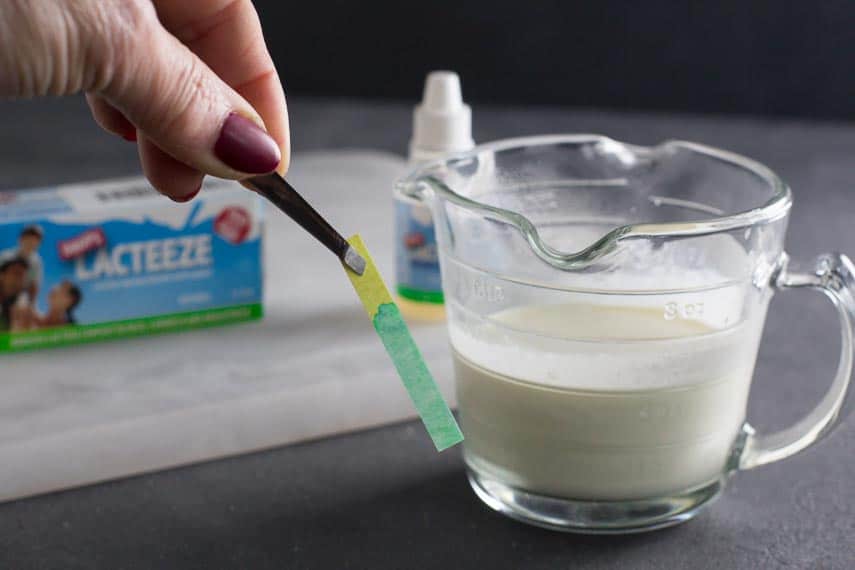
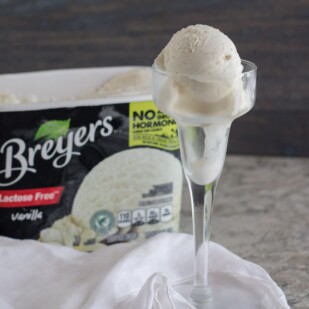
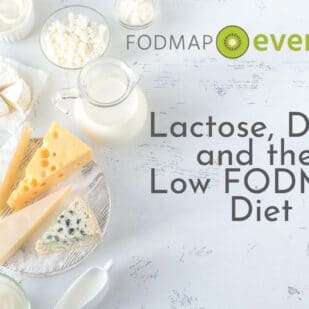






Interesting! I’ve been dying to make clotted cream, but I cannot find lactose free heavy cream anywhere! Why is that? What does the end result taste like after you put the drops in? I tried something like this with a lactase enzyme pill in milk and the whole thing curdled and soured
Hi Sara, Have you had commercially prepared lactose-free milk or half-and-half? It’s similar in that it tastes like the dairy but a tad sweeter. I like that you adventured with enzyme pill LOL…but as you know, those are formulated to go into us, not the dairy itself. I assume that dairy companies have not seen the need for creating a lactose-free heavy cream product, but who knows? It is available in other countries so maybe we will get it eventually. In the meantime, try this! And let us know how it goes for you.
There isn’t a strong demand for free heavy cream because there isn’t very much lactose in it in the first place. The more fat there is in a dairy product, the less lactose there is in it. You can see the lactose if you look on the labels. It will be included as part of the sugar. Skim milk will have more sugar than whole milk, which will have more sugar than heavy cream, and down to butter, which has practically no sugar (lactose) at all.
I’m lactose intolerant, but I wouldn’t bother looking for a lactose free heavy cream, just like I wouldn’t bother looking for a lactose free Parmesan.
His Lisa, heavy cream does indeed have more fat and therefore fewer carbs but it does not go through the same process as hard cheeses. Hard cheeses have lactose-rich whey drained away and a bacterial culture and rennet is added to the curds. The remaining lactose in the curds converts to lactic acid during the aging/ripening process. The FODMAPs reduce. This is the same reason why soft cheeses (cream cheese, ricotta etc.), which are not drained or aged in the same way as Parmesan (for example), have a higher FODMAP content. Many other countries do offer lactose-free heavy cream, and I for one hope that the U.S. will have one soon as well.
Hi Dédé. Does the addition of the Lacteeze drops alter the taste of the milk, cream, etc.?
While purchased dairy with lactase enzymes added does taste a bit sweeter, for whatever reason, this approach does not alter it (or at least not as much) IMO.
Fantastic article! I was always wondering if there was a product to turn dairy into lactose free! and I thought I was silly to think that, lol. Also, it confirmed what I was always worried about with lactose free products, in that you don’t really know how much is added to the product. The pill container says take xx number of pills and adjust as necessary, lol. so how could the milk mixture, for example be perfect. going onto the low FODMAP system, I’ve been experimenting with dairy milk and soft cheeses again, buying the lactose free products. I find that 3/4 cup of lactose free 2% milk, with my coffee, is doable, but better if I take the pills as well. milk in coffee…its been really long time, so it’s great to have options. I will see if I can find the product you use in Canada…:).
So glad you found this informative!
80% conversion does not equal “lactose-free” so why do you keep saying it? This wordy article is a long road to nowhere.
The low FODMAP diet is not Dairy Free and it is lowered in lactose. We are discussing parameters that refer to what is appropriately considered lactose-free enough to be considered low FODMAP. Even if you call manufacturers of “lactose-free” milk to discuss lactose levels they will explain that the product is not devoid. As always, eat to your tolerances.
Have you used lactase powder? If so, how much do you add to make dairy lactose free?
I have not. I would recommend following manufacturer instructions.
Hi Dede- we met years ago as clients of Justin Schwartz. I’m lactose intolerant and have issues with many FODMAPS now. Have you tried adding the drops to cottage cheese? I love Lactaid brand but finding it is hit or miss. I have the strips but might save some time and effort if you have already done this. Thanks so much for all your wonderful recipes.
Hi Penny! Nice to reconnect, albeit under these shared circumstances! You could certainly try it – but how about taking Lactaid caplets? That would be a more surefire way.
If this link works, have a look at the cake I made for my children’s engagement party http://amazingdessertrecipes.blogspot.com/search/label/wedding%20cake
Here is what the text starts with: … I want to re-iterate that although the recipes are mine, the design of the cake came from Dede Wilson’s book The Wedding Book. She used real flowers and I created mine out of sugarpaste, using directions from Scott Clark Woolley’s book Cakes by Design and his DVD, The Amazing Art of Gum Paste Sugar Flowers…
Penny!!!!! This is spectacular!!!! Gorgeous:)
Is beer allowed in low FODMAP diet(s)? Thanks for answering.
We have an article for you on alcohol, including beer, and one on cocktails in general. YES!!!!
Great article, but holy crap you have so many ads and popups. And I couldn’t figure out how to say no to signing up for your newsletter, which was blocking the screen, so I had to enter a fake email address. I’m not in a hurry to come back to this site after that experience…
Hi Miranda, you actually have control over the way ads show on your browser. You can adjust your settings, but we cannot. We make sure that our content is free to the end-user and make a tiny bit via ads. This has allowed us to bring you over 900+ recipes and 300+ article from our Monash trained and FODMAP Friendly Accredited team. I hope you will stick around.
Hi,
I have a few questions 🙂
I read that the longer you wait, the sweeter the milk gets as more lactose is converted.
Now i wonder, is there any way to stop the enzymatic reaction when the desired sweetness is reached?
Or will the milk just get a bit sweeter every day until all lactose is converted?
In that case, is the amount of drops the only way to regulate the final sweetness?
Also, if i add say 2 drops of lactase to 1L of milk, how long will it take for the enzymatic reaction to finish, and if waiting long enough, would all the lactose be removed?
Thanks for your time,
Sascha
Hi,
I have a few questions about regulating the sweetness.
If the longer i wait, the more lactose is converted and the sweeter the milk gets, is there any way to stop the enzymatic reaction? Or will the milk just get a bit sweeter every day?
Is therefore the amount of lactase added the only way to regulate the sweetness of the final product?
And if i add just 2 drops of lactase to 1L of milk, would the reaction continue until all lactase is converted?
Or would it stop at some point (when?) where only part of the lactose has been removed.
Thanks for your help!
Sascha
There really is no way that we know of to fine tune the enzymatic reaction. Perhaps reach out to the folks who make whatever product you are using to ask.
Hello! I made condensed milk from lactose-free milk with a fat content of 1.8.
200g sugar + 1l milk, cooked for about 1.5 hours, the result was boiled condensed milk, thick and tasty!